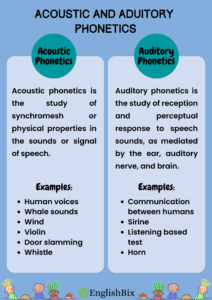In this post, we are about to learn the subfields of phonetics science. So, what does phonetics mean? According to Peter Roach’s opinion, phonetics is the representing of speech in written form by the use of phonetic symbols.
So basically, phonetics is also the branch of linguistics science that focused on the sounds of speech and their pronunciation, combination, production, and representation by written symbols. There are a few kinds of phonetics that are divided based on their characteristic, some of them are acoustic and auditory phonetics. Let’s figure more about it!
Each solid has a wellspring of creation, a mode of movement, and a gathering or insight. For instance, a tuning fork when reverberated produces an unadulterated tone at a fixed essential recurrence. Here the fork is the wellspring of the sound, the state of the fork the source channel, which alters the sound, the air is the mechanism of sound travel and your ear is the discernment organ for the sound.
Presently, human discourse is a significantly more unpredictable marvel than the tuning fork, it has numerous source channels and an intricate mix of both aperiodic (generally consonants) and occasional (for the most part vowels) sounds. Acoustic and Auditory phonetics both examine these highlights from various yet firmly related perspectives.
What is Acoustic Phonetics?
Acoustic phonetics is the study of synchromesh or physical properties in the sounds or signal of speech.
Acoustic phonetics is the investigation of the actual properties of discourse and expects to dissect sound wave flags that happen inside discourse through fluctuating frequencies, amplitudes, and lengths.
One way we can examine the acoustic properties of discourse sounds is by taking a gander at a waveform. Pressing factor changes can be plotted on a waveform, which features the air particles being compacted and tenuous, making sound waves that spread outwards. A tuning fork being struck can give an illustration of the pressing factor changes noticeable all around and how the air particles sway (move in one heading musically) when we see sound.
Characteristics:
- Focused on the sound distribution or the signal speech as we communicate.
- Includes the physical characteristics, such as frequency patterns, friction noise, electronics or mathematical and physical, etc.
- Are affected by numerous factors that make the analysis of the speech signal is more complicated, such as the background noise, anatomical and physiological differences between every human, and many more.
- The main properties of the signal speech or sound wave are wavelength, period, amplitude, and frequency.
Applications:
Here are the few occasion where we find the acoustic phonetics are used, which are:
- The learning activities of the new language. The teacher that teaches some foreign language can use acoustic phonetics so it makes the lesson easier. Because it can be applied to inspect the differences between the sounds of the source and the listener of the language.
- Speech therapy
- Writing and translation
- Language speaker identification
- Understanding the computer language and investigation
- Forensic investigation
- Spevtrogams
- Ocean waves identification
Examples of Acoustic Phonetics
Following are some examples where we can hear how the acoustic phonetics sounds:
- Human voices
- Whale sounds
- Wind
- Violin
- Door slamming
- Whistle
- Trumpet
- Strains
- Xylophone
What is Auditory Phonetics?
Auditory phonetics is the study of reception and perceptual response to speech sounds, as mediated by the ear, auditory nerve, and brain.
It investigates the process that referred to the perception of how human speech, the beginning for this analysis of human speech is a study about our hearing system, that is the anatomy and physiology of our ear, brain, nerves, or even our entire body that are related to the hearing system.
But, as we know, our hearing system can’t react to all forms of action. Because it can only react to the sound wave, so we need to know what we feel (or hearing for this situation), how we interpret and understand it, and also how we communicate back for it, this complex field is called ‘speech perception’.
Characteristics:
- The most less studied subfield of the phonetical science comparatively.
- Focused on the perception of sounds by the way the listeners hear it between two sides of communication participants.
- Rely heavily on biology and more specifically on anatomy and physiology.
Applications:
- For medical purposes. The auditorial phonetics can be applied to the medical field because it can help the medical personnel itself to help you with the problem of your hearing, ear, nose, and throat.
- Identify the phonetic symbol of a word and speech.
- Understanding the interlocutors as we communicate with them.
- Aware of the call to ourselves.
- As the media for our exam.
- Warning sound to inform or to make people realize and identify a certain condition.
Examples of Auditory Phonetics
- Communication between humans.
- Sirine
- Listening based test
- Horn
- RIC, RITE, BTE, CIC, etc. (hearing aid)
Let’s have a quick recap of all what we have learned using the following image.

Quick Links
| Types of Phonetics with Examples in English | Types of Vowels in English Phonetics |
| Examples of Articulatory Phonetics | Types of Consonant Sounds with Examples |

